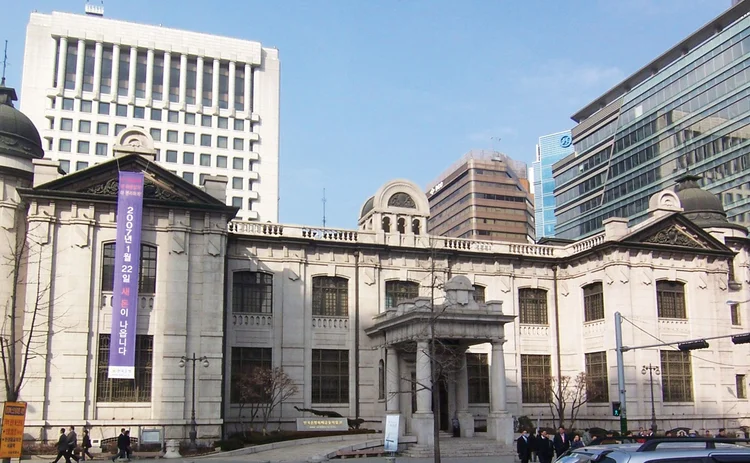
Central bank of the year: Bank of Korea
South Korea’s central bank was the first developed-world central bank to tighten policy to address inflationary risks

The Bank of Korea (BoK) has a reputation as one of the central banks around the world that quietly and competently gets on with its job. Led by the central bank’s longest-serving governor, Lee Ju-yeol (until his maximum term limit in March 2022), the central bank earned a reputation for solid policy-making. But last year, the East Asian central bank became something of a monetary policy leader when it became the first developed-economy central bank – and the first in Asia – to raise interest rates post Covid-19.
The decision to increase base rates in August came amid strong economic growth and rising prices in the nation of around 52 million citizens. South Korea’s year-on-year inflation rate hit 2.6% in July, higher than the central bank’s medium-term target of 2%, having first breached 2% in April. Inflation was rising due to demand pressures that increased as part of South Korea’s economic recovery post Covid-19, as well as from the rise in international commodity prices.
There were concerns at the time that the negative effects of another domestic outbreak of the coronavirus might signal the need for monetary policy caution. Indeed, the message from top central bankers in many other developed markets at that time was that inflation was still very much ‘transitory’ and there was no need to rush toward tightening – it would still be several months before the Federal Reserve Board started to taper its asset purchases, longer still until the policy was accelerated.
However, the Bank of Korea’s monetary policy board raised its policy rate by 25 basis points to 0.75% in August. The increase in the base rate was the central bank’s first since November 2018 and ended a 13-month period where Korea’s main policy rate was at a record-low level of 0.5%. It did not receive unanimous support among the Korean central bank’s seven-person monetary policy board – Joo Sang-yong voted for rates to remain on hold.
Nonetheless, the board said it would “gradually adjust the degree of monetary policy accommodation” as the economy continued to recover from the coronavirus pandemic.
Lee, who was nearing the end of his maximum two consecutive terms, indicated the hike was also needed to lean against growing financial imbalances, which were manifesting themselves in the form of rising asset prices, including for houses, notably in the capital Seoul.
The increases in house prices and household debt were viewed as side-effects of loose monetary policy and fiscal spending triggered in response to the coronavirus pandemic in 2020. “Household loan growth has accelerated and housing prices have continued to increase rapidly in all parts of the country,” the Bank of Korea noted in its August monetary policy statement.
The BoK continued to raise its policy rate, by another 25bp again in November and by a similar level of 25bp once more in January 2022. Lee noted the Korean economy had recovered “more rapidly than expected” in 2021, despite the ongoing impacts of Covid-19. This was largely due to buoyant global demand for Korean exports and a rebound in domestic consumption following the easing of coronavirus restrictions. Korean consumer inflation for 2021 stood at 2.5% – 50bp above the BoK’s medium-term target, but far lower than most of Korea’s developed-world peers.
While some observers viewed the BoK’s policy tightening as ‘hawkish’, in his New Year speech, Lee said rather that the policy actions represented the partial removal of some of the central bank’s unusually easy policy: “The Bank of Korea is gradually normalising the monetary policy stance, which had been highly accommodative since the outbreak of the pandemic,” he said.
The Bank of Korea has maintained a strong focus on longer-term vulnerabilities caused by emergency government and central bank policies. It is aware and appears ready to act to address future challenges, including that of “excessive debt” posing “greater risks” when “the external environment worsens”. “In a situation like the present when external uncertainties are high, we should identify our vulnerabilities objectively and address them properly,” said Lee.
In its latest country report, the International Monetary Fund recognised South Korea’s commitment to controlling risks. “Korea’s financial system has weathered the Covid-19 shock relatively well, a testament to years of sound macro-financial policy management,” the authors of the report said.
As well as raising the base rate three times, the Bank of Korea also phased out some of its temporary financial support measures that were introduced in 2020 to calm financial market unrest and prevent the real economy from shrinking sharply.
In 2020, the Bank of Korea had to increase the supply of won by purchasing local Treasury bonds. It has also improved foreign currency liquidity by temporarily tapping $20 billion of its $60 billion currency swap arrangement with the US Federal Reserve and selling a net $5.9 billion of reserves in the first quarter of 2020 amid depreciation pressures on the won. Another effort involved substantially increasing the volume of its bank intermediated lending support facility, designed to support small and medium-sized enterprises and small business owners. It also undertook an unprecedented financing measure with Korea Development Bank by financing a special purpose vehicle to purchase up to 10 trillion won of corporate bonds and commercial paper, a programme that was phased out by the end of 2021.
Social dimension
Despite its leanings towards normalisation of policy, the Bank of Korea has committed to “actively support” vulnerable sectors suffering from the pandemic so that they can “overcome such hardship as quickly as possible”, said Lee. But the central bank is striving to do this in a way that “future side-effects arising from the support are minimised”.
“We should put more thought into how important social and economic issues… such as demographic changes, increased inequality and climate change, can be reflected in the operation of monetary policy,” Lee said. “Since climate change, in particular, is now an immediate challenge and no longer just a potential risk, we should seek realistic alternatives that allow the use of the bank’s policy instruments for the sake of smooth transition to a low-carbon economy.”
The BoK is also “strengthened lending programmes” for “vulnerable groups, such as small businesses, that continue to suffer from the pandemic”.
A greener future?
As a result, Korea’s central bank is also looking to purchase more environmental, social and governance (ESG)-compliant products for its foreign exchange reserves portfolio.
The Korean central bank built up a large stock of FX reserves in the aftermath of the Asian financial crisis to provide a cushion of funds to meet import payments, foreign currency debt funding requirements and potential portfolio outflows during times of stress. Its FX reserves stood at $461.8 billion as of February 2022. The BoK has closely studied its reserve requirements under potential periods of stress to determine its liquidity requirements and diversified its portfolio into higher yielding assets for some of its excess reserves. The central bank has also made significant investments to ensure its IT systems reserves are fit for purpose, and that it can attract suitable asset management talent.
The BoK’s ESG investment strategy currently aims at diversifying its portfolio, but it may gradually apply ESG assessments to all holdings in the future, it said in a report published late last year. The move comes as South Korea’s government recently unveiled a plan to cut greenhouse gas emissions by 26.3–40% by 2030, as part of its roadmap to go carbon-neutral by 2050.
The central bank is also considering allowing transactions involving green bonds to be used in open market operations. But due to the small amount of green bonds issued locally, the effect of this measure could be limited.
Digital won
The Bank of Korea has also noted that the take-up of ‘contact-free practices’ since the pandemic has prompted a transition to digital services across Korea. Yet, the central bank also recognises that creativity and investment from the private sector are needed as the main engine to support higher productivity and larger growth potential.
As a result, the BoK has partnered with private institutions in its review of the potential use of a ‘digital won’. The central bank has conducted central bank digital currency (CBDC) research since April 2020 in preparation for a “cash-free society”. It started a test of a digital won, with a budget of 4.96 billion won ($4.44 million), in August last year – selecting GroundX, a blockchain affiliate of the nation’s tech giant Kakao Corp, via a public tender notice.
The test is examining the functionality of CBDC in a virtual environment, after which the BoK will then decide whether to introduce the digital won for broader use. The BoK describes the model as a “public-private partnership” where the central bank oversees the issuance and redemption and the private sector handles the distribution.
The BoK concluded the first phase of the trial at the end of last year. During this period, the central bank tested basic CBDC functions, such as issuance, distribution and remittances. The BoK will test cross-border payments and offline payments in the second phase of the project, which is scheduled for completion in June 2022.
The BoK stores the digital won on its own systems until participating institutions request issuance of the CBDC. Users can make payments using digital won via electronic wallets provided by participating organisations. The e-wallets will also be used to exchange the CBDC with regular bank deposits.
The test does not imply any immediate plans to issue a CBDC to the public, the BoK has stressed. But the central bank added it is aware technological innovation in the payments services sector is evolving rapidly and might require monetary authorities to issue a digital currency in the longer term.
Challenges ahead
While some observers have described the Bank of Korea’s policy moves as ‘hawkish’, many seasoned experts would call them ‘prudent’.
Although the central bank faces challenges in its efforts to curb inflation while keeping yields under control amid government spending pressure, overall, the Bank of Korea has managed its core tasks in a stable manner for many years.
The Korean central bank appears to be well placed, despite challenges ahead, as Rhee Chang-yong, previously director for the Asia and Pacific department at the IMF, takes over as governor.
Only users who have a paid subscription or are part of a corporate subscription are able to print or copy content.
To access these options, along with all other subscription benefits, please contact info@centralbanking.com or view our subscription options here: http://subscriptions.centralbanking.com/subscribe
You are currently unable to print this content. Please contact info@centralbanking.com to find out more.
You are currently unable to copy this content. Please contact info@centralbanking.com to find out more.
Copyright Infopro Digital Limited. All rights reserved.
As outlined in our terms and conditions, https://www.infopro-digital.com/terms-and-conditions/subscriptions/ (point 2.4), printing is limited to a single copy.
If you would like to purchase additional rights please email info@centralbanking.com
Copyright Infopro Digital Limited. All rights reserved.
You may share this content using our article tools. As outlined in our terms and conditions, https://www.infopro-digital.com/terms-and-conditions/subscriptions/ (clause 2.4), an Authorised User may only make one copy of the materials for their own personal use. You must also comply with the restrictions in clause 2.5.
If you would like to purchase additional rights please email info@centralbanking.com






